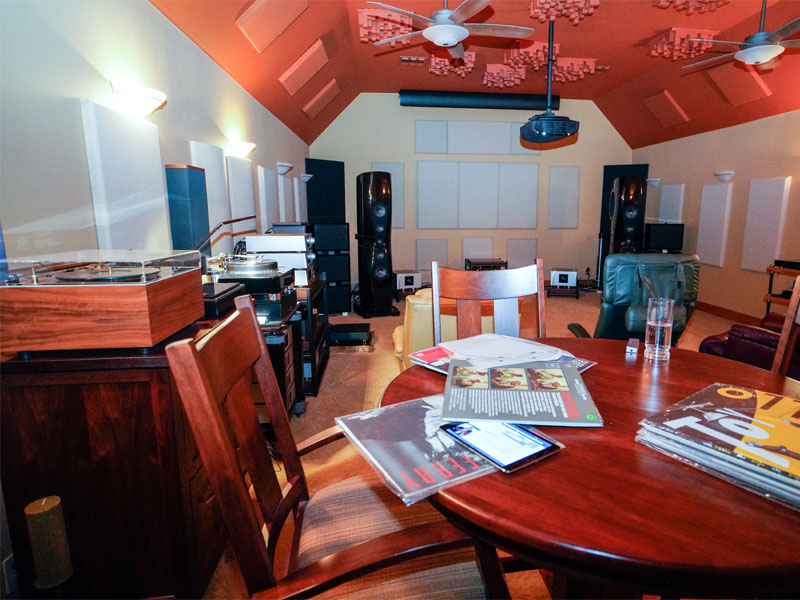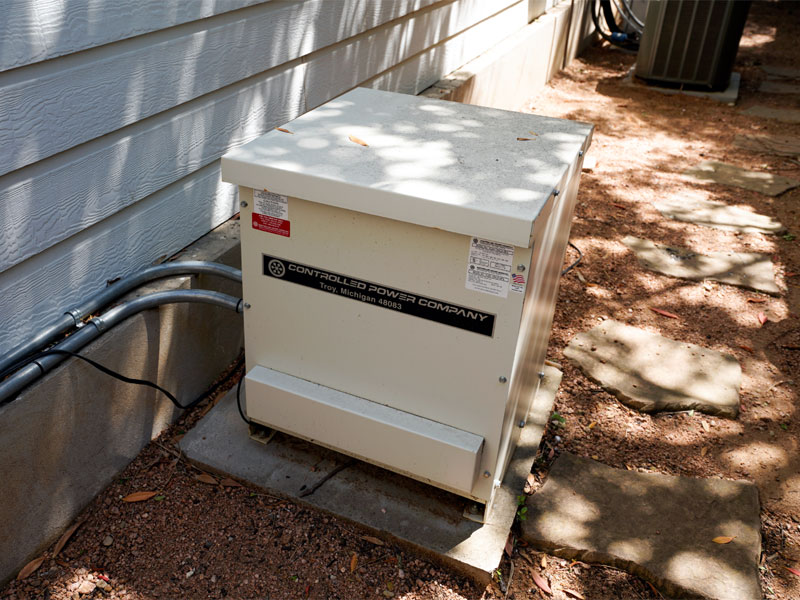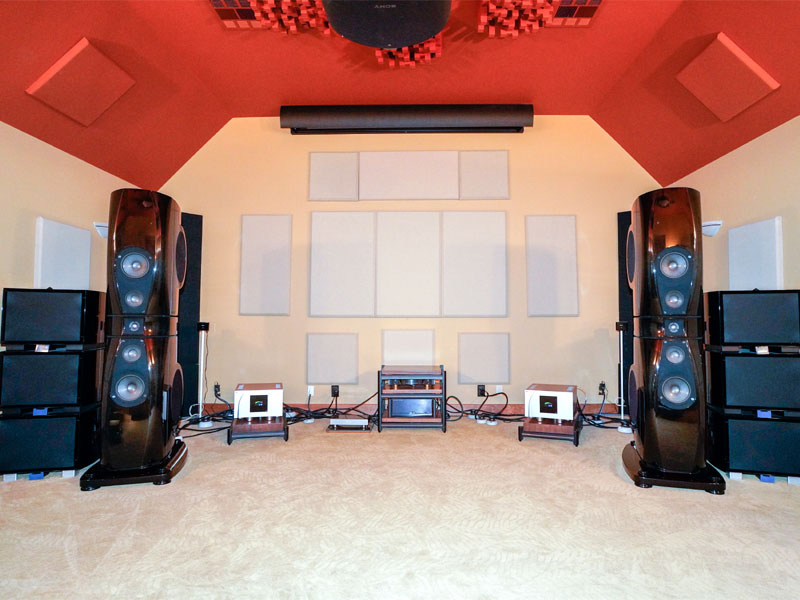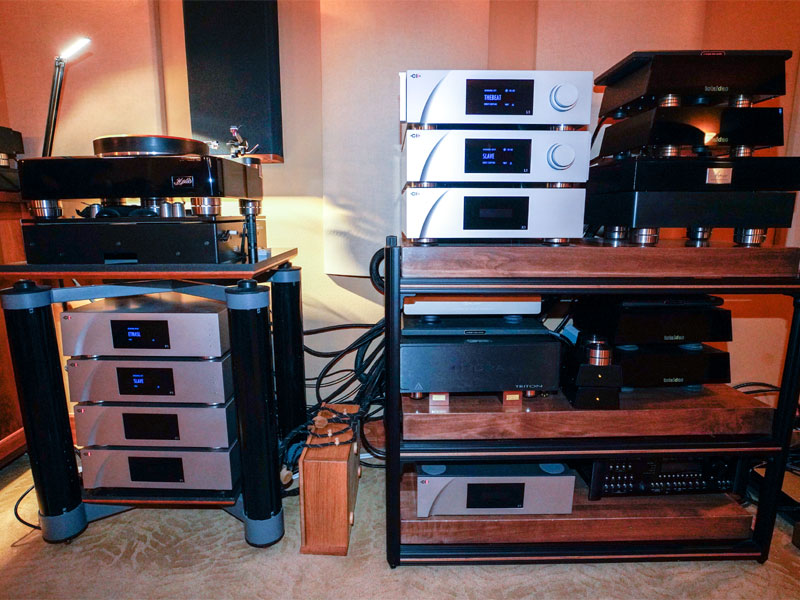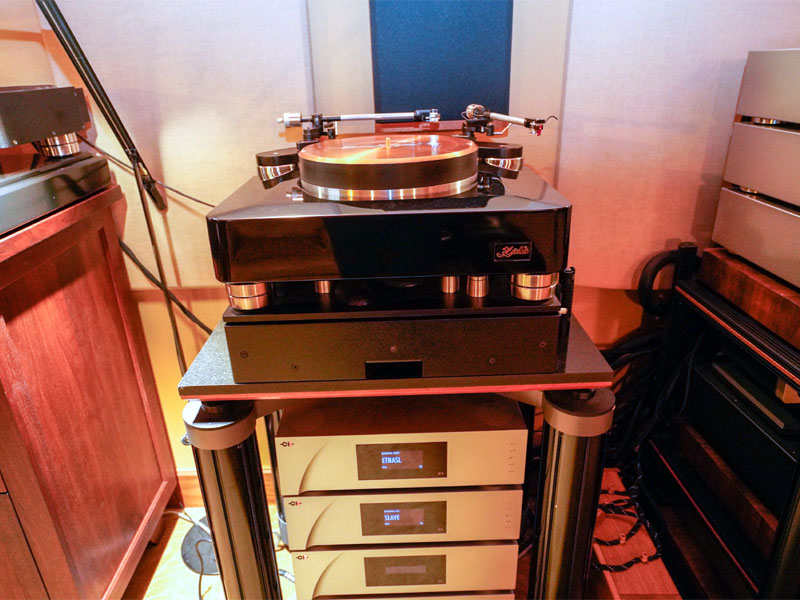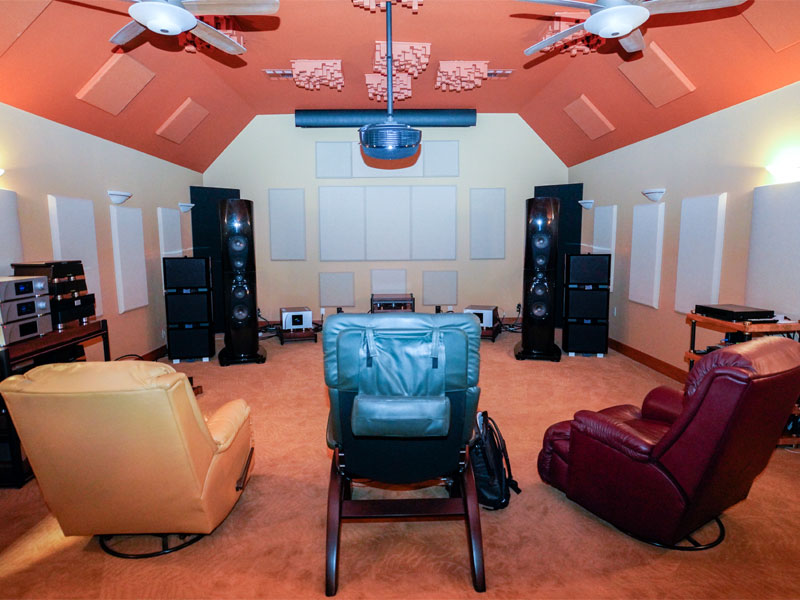System Notes: Deep in the Heart of Texas
Think of Texas and stereotypes abound. Whereas I can cover my head with a baseball cap, Texans require a ten-gallon hat. The cattle have long horns. The cowboy culture requires big barbecues and even bigger trucks. Austin claims to be the musical capital of the world, and it's hard to disagree during the SXSW music festival. You could pack more than a dozen of those dinky East Coast states into one Texas. Go to Austin, the Texas capital, and drive past the capital building and your Uber driver is likely to let you know that it’s bigger than the equivalent in Washington, DC. I had to fact-check that claim and learned that, while it may be 15 feet taller than the federal equivalent, it is not strictly larger. Having said that, standing in the rotunda of the Texas state capital building, it certainly looks like a long way up to the lone star.
Arriving at the hosts’ home in Austin, I was slightly disappointed by the absence of Texas drawl. Arnie and Laura Sanders are, in fact, East Coast transplants to the Texas Hill Country, arriving there because of Austin’s identity as "Silicon Hills," a name derived from California’s Silicon Valley, rather than from Texas geography. As software and hardware engineers working for IBM for much of their lives, the Sanders met and married their jobs, transferring around the country before finally landing in Texas. Arnie retired 12 years ago, and his Texas-sized listening room is largely the product of his passion for music, his interest in equipment and software being reignited and redirected since leaving IBM. Laura’s music room, far from the large room, contains a baby grand piano, on which she practices for hours. Meanwhile, Arnie and I played the audio system, the only musical instrument from which we could coax a reasonable facsimile of music. Arnie grew up in a home with a serious audio system, back in the day when building a system meant more than buying finished components. His dad built his own gigantic speaker arrays, with multiple 15" drivers. He literally constructed his own electronics, assembling kits purchased from the Heathkit catalog. Records spun on a Garrard 301 transcription turntable, completing a collection of pretty cool gear. Nature or nurture, Arnie seemed predestined for a large and complex stereo system, although he didn’t put down roots right away. After graduating from college in 1974, he stopped listening to vinyl because he was transferred around the country on work assignments. Although he never lost his love for music, his deep fascination with playback equipment went into hibernation for many years. When it finally reappeared, it swept back into his life like a Texas hurricane.
t’s often tempting to reduce life’s slings, arrows and changes to pop-music lyrics, and, given Arnie’s expansion into serious hi-fi after retirement, it’s easy to think of Leonard Cohen.
I’m not saying Arnie didn’t love engineering software bits, and maybe I’m just projecting, but can anything really compete with waking up one day and realizing that you no longer need to commute in all that nine-to-five traffic, while simultaneously realizing that the most difficult question facing you now is "Where the heck am I going to install the new stereo system?" As Arnie started getting serious about his hi-fi, he knew that he needed to improve upon his existing man cave, a fairly large room over the garage. So ten years ago he started over, demolishing his old room, expanding it and incorporating the Acoustic Sciences Corporation (ASC) Iso-Wall System -- a triple-wallboard, floating-wall construction, with floor membranes intended to stiffen the overall structure and damp vibrations. After completing construction, he then added a host of room-treatment materials from ASC. The room itself is 33 feet long, 20 feet wide and has a 12-foot ceiling.
At the same time he retained Art Kelm of Ground One to design and install a robust electrical system, including proper grounding, a huge isolation transformer from Controlled Power Company between his home and the power line, and a dedicated breaker panel with bolted-in breakers for his stereo room, to feed a dozen dedicated lines. Kelm also specified that the dozen circuits would run specially designed in-wall power cable -- three individual stands of 10-gauge solid-core copper wire that were manually twisted on 1" centers as they were pulled through flexible steel conduit.
As the 21st century dawned, long before the reconstruction project was underway, Arnie had already succumbed to the urge to rediscover his audiophile roots. What better way to treat the audio disorder than with the Vandersteen antidote? Arnie’s first high-end speaker was the Vandersteen 3A Signature, introduced in 1999. That experience was only the first of a dramatic chain reaction that led to the acquisition of a pair of Magico M5s about a decade later. Just pause for a moment and consider that journey in terms of simple mass: the Vandersteens weigh in at 90 pounds each, whereas the Magicos tip the scale at 360 pounds each. While the Vandersteens are still at Casa Sanders, they’ve moved on to a smaller listening room to make space for more ambitious -- actually, make that huge -- speakers. Rather than growing complacent with his Magicos, Arnie visited audio shows and the homes of fellow audiophiles to obtain a point of reference, leading him to conclude that the Magico M5s were a little bass shy for his tastes. Eventually he found the speaker of his dreams, the perfect speaker for his room -- a pair of Rockport Arrakis 2s, 900 pounds a side and $225,000 the pair. Installing the massive Arrakis was no easy feat, as his listening room is on the second level, reached via a staircase with a hairpin turn at the top. Even with each speaker breaking down into three separate cabinets, it was a trial of faith and physical exertion just getting the speakers up the stairs. When his floor didn’t collapse, he decided to add subwoofers, and chose the REL Acoustics "six pack": twin towers of three Gibralter-2 subwoofers ($4000 each, so $24,000 total) just to reinforce the bottom end. At first, Arnie drove his Arrakis 2-based system on tube power, four VTL Siegfried mono amplifiers, along with an Absolare Altius preamplifier and an Allnic Audio H5000 DHT phono stage. Anyone would be forgiven for thinking of this as a dream system, but with Arnie, a funny thing happened on the way to the opera. Instead of staying home, locking himself in his music room and occasionally pinching himself to make sure he wasn’t dreaming, he left his home and listened to a friend’s system -- a friend who had recently acquired a CH Precision preamplifier. Having finally found his speakers, that was the start of his next journey, a love affair with CH Precision’s Swiss-built equipment.
The first thing to go was the Absolare Altius, replaced with a CH L1 dual-mono preamplifier ($58,000). Read Roy Gregory’s recent review of the CH Precision kit and you’ll soon appreciate that in the land of cuckoo clocks, dual mono takes on a whole new meaning. In this case it translates into two separate audio chassis, each stereo-capable but in this case dedicated to a single channel. along with two X1 power supplies (again, one for each channel, $17,000 each). Arnie says he was so blown away by the improvement wrought by the new control unit that it wasn’t long before he took the next step and switched out the Allnic phono stage for a CH Precision P1 ($55,000), again each channel with its own X1 power supply. From there he took the electronics chain to a single family by replacing his VTL Siegfrieds with CH Precision M1 power amplifiers ($104,000 per pair), configurable for stereo or mono operation. And don’t think he’s done yet -- his Arrakis 2 speakers require biamping, so although he’s running the M1s in stereo biamp mode, he is seriously thinking of adding a second pair of M1s.
The front-end of this system is equally imposing. Arnie's turntable is a Kodo The Beat from Xact Audio, with two Schröder LT tonearms ($44,000 for the 'table with one 'arm, plus $12,500 for the second 'arm). The direct-drive The Beat is the creation of Steve Dobbins, who is also Arnie’s audio dealer. Steve commissioned Frank Schröder to design a special version of his pivoted, linear-tracking 'arm, asking for a magnesium armtube in place of Schröder’s preferred wooden wand, and this is what Arnie uses. The table rests on a Minus K BM-8 stand ($2900) placed on top of an Adona Zero GXT turntable rack ($2640). Arnie favors Lyra cartridges and uses an Etna ($8995), an Atlas ($11,995) or an out-of-production Olympos (north of $10,000 when still available). The Etna was mounted in the front tonearm, and all our listening was done with it. Digital is supplied via a TotalDAC d1-twelve ($38,000), a three-box system composed of two mono DACs and a reclocker. TotalDAC is a French company specializing solely in DACs and streamers. There is no disc drive in this system; all digital music is played back from computer files. Hooking up this mountain of equipment is no mean feat, and connection involves a massive range of products. Cables from Echole, Tel Wire, AudioQuest and Shunyata Research tip the scales at about $340,000. For indoor power conditioning, Arnie uses a Shunyata Hydra Triton v3 power conditioner ($9000) for the analog front-end components and a Shunyata DPC6 v3 ($5000) for the computer-based music components. Other than the turntable, the equipment rests on a Steve Blinn doublewide component rack ($2500) with the amps on a pair of Steve Blinn amp stands ($1200 each). These, in turn, use (mostly) Stillpoints Ultra 5s ($699 each) liberally distributed to support the components.
I spent a day listening to this truly impressive system, along with Arnie (center), Steve Dobbins (left) and Raphael Pasche of CH Precision. Arnie may be a very hands-on type of audiophile, getting very involved in the selection of equipment and design of his room, but he’s also wise enough to know what he doesn’t know and when to rely on professional guidance. So it was great to have Steve and Raphael attend our session, supplying extra detail as well as a very different perspective on what has been both an exciting and daunting project. Like all right-thinking audiophiles, Arnie prefers the sound of vinyl to digital. His record collection is lovingly housed in custom-made wooden cabinets. Pull out the drawers, which hide the LPs from view, and you flip through the collection front to back, rather than turning your head sideways to read LP spines. As with any serious record fanatic, he cleans his vinyl, in this case with a Loricraft PRC4 Deluxe record-cleaning machine ($3725). As already noted, he has abandoned CD and relies entirely on computer-based digital music. Many audiophiles pursuing the goal of an ultimate system do so as homage to "the absolute sound," seeking a more accurate facsimile of that audio gold standard, the symphony orchestra. It’s a goal that demands exactly the sort of wide frequency response and dynamic headroom that this system has in spades. But it’s not the goal that drove Arnie. His tastes run to small-scale acoustic music, including jazz as well as pop, recordings rendered breathtakingly present and dimensional when played on a system like this. So, contrary to appearance, this is a big system that’s designed to do small. That’s not to say that Arnie doesn’t like to rock out, his Stevie Ray Vaughan collection showing just how amazing amplified guitar sounds on a really big system. By and large, however, Arnie tends to gravitate to smaller-scale music, and we spun Masterpieces by Ellington [Analogue Productions APJ 4418], Ben Webster & "Sweets" Edison [Original Recordings Group ORG 117] and Shelby Lynne’s Just A Little Lovin’ [Analogue Productions APP 41], all records I’ve played dozens of times on my own system and on a wide variety of show systems. Steve Dobbins brought along a pile of records to play, ones that showed off what a really big system can do -- like Yello and other techno music I’ve either never heard or not listened to in a very long time. With the first round of show-and-tell complete, it was time to play some of the music I’d brought along. Arriving by air and already having a handle on Arnie’s musical tastes, I’d confined myself to a handful of classical CDs that were duly downloaded onto Arnie’s hard drive, giving us the opportunity to hear just how the big rig handled large-scale classical music. In a word, brilliantly -- with all the scale, power and authority I would expect, but with the essential coherence and intimacy that really let a performance breathe, pulling me into the same space as the orchestra. Just like live music, the proof of the audio pudding is in the audience reaction, and Lisa Batiashvili’s performance of the Tchaikovsky Violin Concerto (with Daniel Barenboim conducting the Staatskapelle Berlin [Deutsche Grammophon Gesellschaft 479 6038]) had the assembled listeners scrabbling for pen, paper or phone to make a note of the disc's details. If the true measure of system quality is the ability to play anything, then here’s the proof that Arnie’s system is no one-trick pony, acing the audiophile acid test, even if it wasn’t designed to do so. Other than the lack of a CD transport, there was little to stop me from loving Arnie’s equipment choices. Despite their massive size, the Rockport speakers did a great job of getting out of the way, letting small-scale music sound appropriately small while expanding nicely when called upon to reproduce the big stuff. And while I am a card-carrying tube fan, the CH Precision gear is perhaps the first silicon-based non life form to not only challenge my assumptions but to grind them to dust. Ben Webster & "Sweets" Edison never sounded more tubelike, and Ellington was just where he should be, rather than seemingly suspended five feet over my head. The enormous bass platform was dialed in perfectly. Violin sound, always a danger zone with some speakers and electronics, was beautifully rendered. Anyone who has visited the super-system installations at audio shows knows how often a multi-hundred-thousand-dollar system can make you feel like insects are invading your middle ear. Not so with this system, one that I could easily live with if I won a very large lottery jackpot. Failing that and lacking the space for 900-pound speakers, the addition of CH Precision gear alone would be sufficient to propel me an awful long way toward nirvana.
t the end of the day, not everyone who loves music and audio reproduction can afford the space or expense of a purpose-built room filled with state-of-the-art equipment. When I returned home, my first impression upon entering my music room was that I was looking down at my Wilson Yvette speakers, which most non-audiophiles consider gargantuan. My suspended wood floor would collapse under the weight of Arnie’s Rockports, and my 8’ 3" ceiling would only accommodate the speakers once the floor had given way. For those of you who can accommodate such ambitious speakers, listening to them makes the musical returns all too obvious. Accessibility to the drop-dead-gorgeous direct-drive Kodo turntable and world-class electronics from CH Precision is more universal -- funds permitting. Who wouldn’t lust after such sonic gold? But in the case of Arnie's system, it’s not about audiophile bling. Few of those who have the means and opportunity to afford such equipment are motivated by purely musical concerns. We all have a fascination with equipment, with the records themselves, and with the minutiae of system setup and tuning, but for each of us the balance of those fascinations differs. Arnie loves his system. He loves the equipment and the process of selecting it. But he also spends four to five evenings a week simply listening, and only someone with an abiding passion for music is going to sustain such a time-consuming schedule, no matter the level or sophistication of the playback equipment. Love of music, once contracted, is addictive, and that addiction can lead down many different and unexpected roads. Leonard Cohen may be right about there being no cure for love, but there is a salve, and perhaps a cure, for the love of music and its reproduction in your home. Arnie clearly loves small-scale acoustic music as much as he loves big electric-guitar sound and electro-pop. His carefully selected components tick an awful lot of sonic and musical boxes, and there’s no ignoring just how accomplished they are when dealing with his preferred material. His top-notch analog front-end is certainly helping him make up for his quarter-century away from vinyl replay. Which brings us to that inevitable audiophile question: what next? After all, no matter how much you’ve invested, there’s always the option (or compulsion) to seek further upgrades. Add a second pair of CH Precision M1s? That seems like the obvious step, although recent experience suggests that, were it me, I’d consider a time out. Before investigating additional equipment, I’d want to check that I was getting everything out of the kit I already owned, so my next step would be to call Stirling Trayle at Audio Systems Optimized. Having been on the receiving end of his treatment, I was astonished by both the magnitude of the results and just how cost-effective they were, even in the context of my own relatively modest system. Stirling’s ability to extract even more performance from an existing system is remarkable, especially when it comes to optimizing the passive components and speaker setup. And if Stirling can’t add to a system’s performance, he’s the first to throw up his hands and acknowledge that fact. But, being purely selfish for an instant, I would love to know what he could do with a system like Arnie's. But as it stands, this is one impressive system -- and
one happy listener. By matching its owner’s needs and expectations, it demonstrates
categorically that there’s life left in the high-end promise: that expensive audio
really can deliver rewarding music, even without further upgrades. But whichever
way Arnie decides to go, one thing is for sure: if nothing else, his room is large enough
for the addition of a lot more record cabinets, and with well over a ton of speakers at
one end, an enlarged vinyl collection at the other could be considered sensible insurance
against cosmic imbalance. I’d hate to see the room starting to tilt to the speaker
end. Besides which, all those extra records -- that really is something to look
forward to. |


